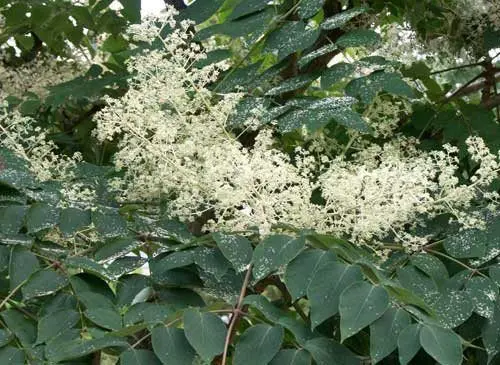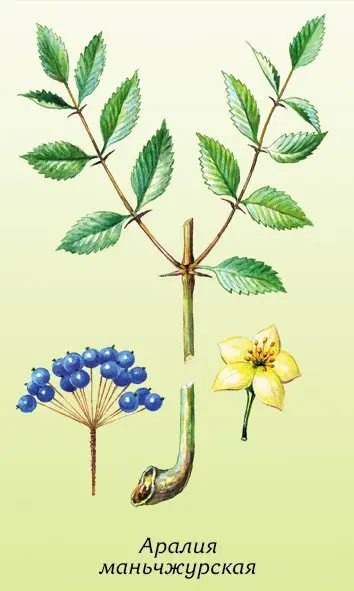Contents
- Medicinal properties and use of the Manchurian Aralia root in folk medicine
- Description of Aralia Manchurian
- Healing properties of Aralia Manchurian
- The use of Aralia Manchurian in folk medicine
- The fruits of Manchurian Aralia are not interesting for traditional medicine
- Benefits of Manchurian Aralia Roots
- The use of Manchurian aralia for food
- Recipes from Aralia Manchurian
- Tincture from the roots of Aralia Manchurian
- Contraindications for the use of Aralia Manchurian
Medicinal properties and use of the Manchurian Aralia root in folk medicine
Description of Aralia Manchurian

The plant genus includes 35 species that grow in North America, Australia and Asia. This is a fairly fast growing tree. The trunk of the plant is covered with thorns, it has few branches. The plant is a tree, reaching a height of 15 m. It has large leaves that grow on long petioles in the upper part of the trunk (it is interesting that because of this feature, Aralia is sometimes called the Far Eastern palm tree). Aralia leaves turn yellow or red in autumn. The flowers are small, yellowish-white. They are collected in inflorescences, consisting of several umbrellas, which look like panicles, which are about 45 cm long. They bloom in mid-summer. Small black fruits of the plant ripen in early autumn. Each of the five seeds that develops in the fruit is protected by its own seed.
The plant lives no longer than 25 years. The tree has a fairly strong frost resistance and is practically not susceptible to fungal diseases. Interestingly, it is not affected by pests, except for slugs.
This plant is distributed only in the Far East. It grows singly or in small groups, preferring forest edges. Medicinal raw materials for Aralia are roots, bark, and leaves. The time of collection and harvesting of the plant is April and May, September and October.
The devil’s tree, as the aralia is also called, has strong medicinal properties. In medicine, mainly the roots of Manchurian aralia are used.
Aralia is suitable for hedges, as it is decorative. Is a honey plant.
Healing properties of Aralia Manchurian
The main diagnoses for which aralia is indicated are post-influenza asthenia, sexual impotence, impotence, diabetes mellitus, physical and mental overwork. Preparations prepared from the plant have a stimulating effect on the central nervous system. The effect of the use of funds from Manchurian aralia is stronger than from ginseng. Aralia has a strong anti-stress effect.
Aralia has recently been used in folk medicine. Its properties were discovered as a result of the search for an analogue of ginseng among plants of the Araliaceae family.
The use of Aralia Manchurian in folk medicine

In folk medicine, aralia tincture is used as a tonic and regulating agent for the central nervous system.
A popular remedy in the treatment of atherosclerosis, brain diseases, cerebral sclerosis, schizophrenia and diabetes mellitus. Preparations from Manchurian aralia do not have a particularly strong effect on blood pressure, slightly stimulate breathing and have a cardiological effect. Since the plant has a rather strong hypoglycemic effect, it should be said about the possibility of increasing appetite, but this is not critical.
An increase in appetite in this case does not always lead to an increase in body weight, because the medicinal plant also increases the overall activity of the body, increases its performance, and if the amount of food consumed increases, then the amount of energy that the body spends also increases. This important property of aralia can be used to regulate appetite in children. Most of the patients who are treated with aralia products notice an improvement in well-being, namely, improved sleep, increased appetite, and a decrease in heart and headaches. The positive effect appears relatively quickly.
The fruits of Manchurian Aralia are not interesting for traditional medicine
Very often the question is asked: how can the fruits of aralia be used? The answer to this question is this: the fruits of this plant have an exclusively decorative purpose. They are simply inedible and are not used in traditional medicine.
Benefits of Manchurian Aralia Roots
The roots are harvested from the plant. They are harvested in early spring or autumn. After the roots are cleared from the ground, wash them quickly, cut into pieces of 15 cm. If the roots are thick, split them along the length. After these manipulations, the roots should be dried in a warm room, and preferably in a special dryer, where the temperature is not higher than 30 ° C. The shelf life of the prepared raw materials is two years.
The roots of the plant contain gum, starch, vitamins C and B, essential oil, flavonoids and sitosterol.
The use of Manchurian aralia for food
The young leaves of the plant are suitable for use in boiled and fried form, as well as forage for cattle and deer.
Recipes from Aralia Manchurian
Aralia root decoction is especially effective for gastrointestinal diseases, colds, diabetes, relieves inflammation in the oral cavity, treats enuresis, and is popular as a general tonic. A decoction is very effective for kidney disease, as it helps to increase the separation of urine.
20 grams of raw materials are poured into 150 ml of hot water, boiled in a sealed container for 30 minutes. Then cooled at room temperature for 10 minutes, filtered, squeezed. You can store the product in the refrigerator for no more than 3 days. You should take 1 tbsp. spoon 3 times a day before meals. The course of treatment is two to three weeks.
Tincture from the roots of Aralia Manchurian
In order to prepare a tincture, you need to pour 40 grams of roots with one glass of 70% alcohol. You need to insist it for 14 days, then strain and squeeze. The finished tincture will be amber in color with a specific smell, but a rather pleasant taste. You need to drink it with meals, about 35 drops each. It is recommended to take three times a day for a month.
Important note: if the patient has a tendency to high blood pressure, you need to reduce the dose to 10 drops and drink 2 times a day. In this case, the course of treatment will be about three weeks.
It turns out that this tincture has a beneficial effect on patients prone to asthenic syndrome that occurs after the flu. At the same time, the positive effect from the use of aralia is achieved three times faster than from treatment with medications.
Tincture from the roots of this plant is prescribed for depression, impotence, mental and physical overwork.
Contraindications for the use of Aralia Manchurian
It is important to note that you can use the products prepared according to the recipes in this article only under the supervision of your doctor. Medicines from aralia are contraindicated for people suffering from hypertension, increased nervous excitability, epilepsy and insomnia. Do not use decoctions and tinctures based on the plant in the evening to exclude sleep disturbance. It is very important to remember that all parts of aralia contain toxic substances. You need to be careful, as poisoning can be provoked, the main symptoms of which are loss of consciousness, respiratory failure and bleeding.









